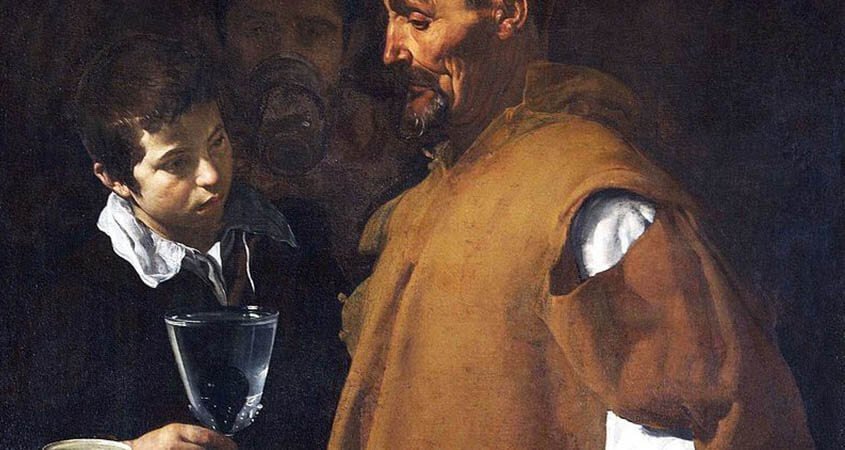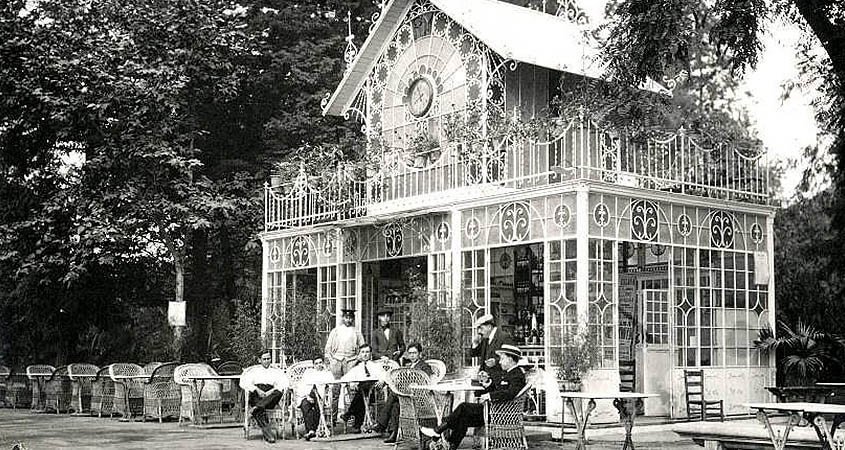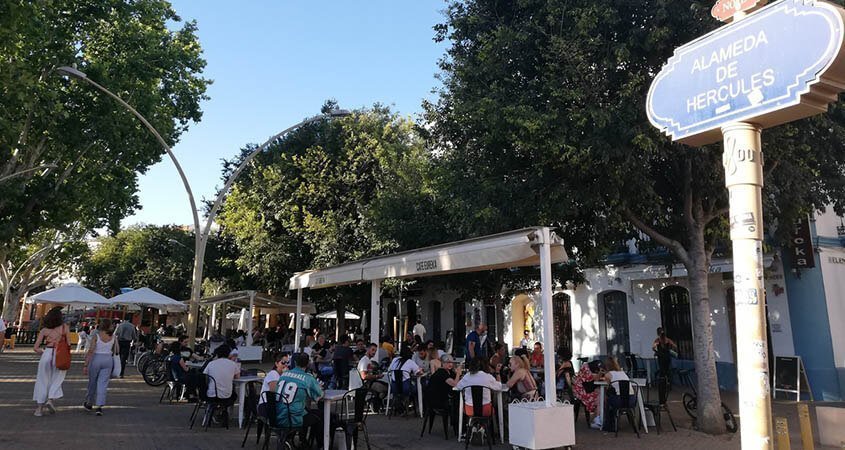The Alameda square in Seville is considered the oldest public promenade in Europe, although it is contemporary of the Paseo del Prado in Madrid and previous to the famous one of the Tullerias in Paris. We have had our Mall since 1574, thanks to the Count of Barajas, corregidor of the city at the service of King Felipe II.
Hércules, Julio César and the roman columns in the Alameda square
The name of Alameda de Hércules is due on the one hand to the poplars that adorned the square and on the other to a sculpture of the classic hero Hercules that opens the square at one end. Hercules is considered the mythical founder of Seville. And next to Hercules we also see Julius Caesar, to whom the first wall of the city in Roman times is attributed.
Both characters are on top of two monumental columns of about 9 meters. They came from a Roman temple apparently from the time of the emperor Hadrian, of which there are still three other columns in the hidden marble street, named for the columns.Ambos personajes están en lo alto de dos monumentales columnas de unos 9 metros. Provenían de un templo romano al parecer de época del emperador Adriano del que aún quedan otras tres columnas en la escondida calle mármoles, llamada así precisamente por las columnas.
The sculptures are by Diego de Pesquera, author of the 16th century. Hercules, in addition to the mythical founder of the city, represents Emperor Charles V and Julius Caesar’s, also Philip II who reigned then.
There are two other columns at the other end of the plaza that are from the 18th century. At its top are two lions, one with the coat of arms of Spain and the other with that of Seville.
If we measure the distance between both pairs of columns, we see that the Alameda is the square in the largest historical center of Seville: measures: 480m. Almost half a kilometer of walking.
In this place before the Alameda there was a swampy area, the Laguna de la Feria. We are actually very close to the river. The Count of Barajas task was to dry it out and turn it into a walk with fountains and trees that protected it from the summer heat. It was a center for social gatherings where all kinds of social classes coincided.
Water in historic Seville. Alameda square and public fountains

In the Alameda square in Seville three fountains were installed that gave drinking water from the Archbishop’s fountain, a spring in Miraflores, 3 km north of Seville.
The water carriers were a classic figure in Seville. They carried the water from these public sources to the houses. The Alameda’s water was especially appreciated for its quality and the water carriers used to carry a twig of poplar in the pitchers that ensured its origin in this square. Diego Velázquez left us in one of his immortal paintings a representation of this profession.
The one known as the Aguador de Sevilla (The water carrier of Seville), today in the Wellington museum in London, belongs to his first paintings and it was painted in Seville. The three characters represent the three ages: youth, maturity and old age. The oldest character is the water carrier who pours water from his pitcher into a young man’s glass cup. The naturalism and textures of the objects represented (ceramics, glass …) is what stands out most in this Baroque painting from the early 17th century.
This formerly swampy area improved its appearance and functionality, but it continued to flood often as the river was very close. The floods reached it so much that it came to be called the plague lagoon, due to the epidemics of typhus, cholera… derived from the floods and unsanitary conditions.
This was a serious problem until well into the 20th century when the river deviated and the Guadalquivir on its way through Seville became a canal.
Games and social activities in Alameda square

During the 18th century, the city will have a large interior space in the Alameda where you can “play canes” or “run bulls, the origins of bullfighting. The canes game was very popular in Spain. It was of Arab origin and consisted of a simulation of a combat in which nobles on horseback threw reeds or darts and others stopped with the shields.
Evolution of Alameda of Hercules square

The appearance of the Dukes of Montpensier in Seville led the highest classes to new spaces south of the city. And this northern area remained a popular neighborhood. In the middle of the 19th century, the Alameda had an illustrious neighbor, the romantic poet Gustavo Adolfo Becquer, who was born in a nearby street and who later lived with relatives in the Alameda itself.
At the beginning of the 20th century, the Alameda square area gained a notable economic and social boost with the installation of theaters, stalls, and beverage kiosks.
After the civil war it became a fairly degraded area. And it has recovered in recent years with the redevelopment in 2008 and today it is an area of much social and cultural activity in Seville. To highlight in the latter the beautiful palace of the Casa de las Sirenas (Siren’s House) from the 18th century and which is the most notable building in the square, today a civic center.
Why not doing a guided tour by the historical sites in the city including the Alameda of Hercules? have a look of our tours and ask us https://www.toursevilla.com/en/
More info of this lively square or boulevard (in English) https://www.visitasevilla.es/en/professionals/sevilla-venues/alameda-de-hercules-boulevard
Alameda is one of the best quarters for night life, bars and restaurants. Here you have a few places to eat well https://www.yelp.com/search?cflt=restaurants&find_loc=Alameda+de+H%C3%A9rcules+33%2C+41002+Sevilla
